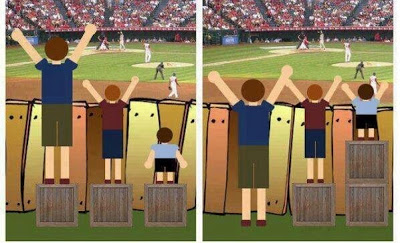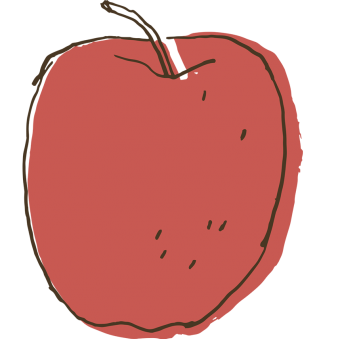Imagine a world where everyone was awarded the same opportunities and the playing field was fair…not equal, but fair? WOAH! Snap back to reality…not the case. Unfortunately we live in a world where depending on where you come from (both live and the family you were born into), how much money you have, if you are a certain race or of a certain capacity,etc. it often determines the opportunities that you are awarded. First, what does it mean to have something be “fair but not equal”? I love the imagine below…you’ve probably seen it, but take a minute to really look at it and think about the implications of this concept.

Image via: HERE!
Equal would be giving each of these people 1 block – there were 3 available, there are 3 people, each person should get 1. However, although this is equal by definition, it really only helps one of the people in the picture. The first person does not need to be higher over the fence, the middle person can finally see but our shortest person still can’t even come close to seeing over the fence. When we distribute the blocks fairly each person in the photo gets what they need, as pictured on the right side of the photo. Open education has the potential to be the right side of this photo! We can fairly distribute opportunity and knowledge so everyone has the chance to better themselves.
In my awesome classmate Colleen’s blog this week she asks one of the most important questions about “open education”, what does it actually mean? By direct definition, “Open education is a philosophy about the way people should produce, share, and build on knowledge. Proponents of open education believe everyone in the world should have access to high-quality educational experiences and resources, and they work to eliminate barriers to this goal. (Source: here)
But, what “Does “open” mean openly licensed content or code? And, again, which license is really “open”? Does “open” mean “made public”? Does “open” mean shared? Does “open” mean “accessible”? Accessible how? To whom? Does “open” mean editable? Negotiable? Does “open” mean “free”? Does “open” mean “open- ended”? Does “open” mean transparent? Does “open” mean “open- minded”? “Open” to new ideas and to intellectual exchange? Open to interpretation? Does “open” mean open to participation — by everyone equally?”(Farrow, 2017) We can’t properly assess or have an educated, for lack of a better term, conversation about the pros and cons of offering education to all if we don’t understand what it means.

Image via: HERE
I thought the above diagram did a nice job of answering some of those questions by showing how many facets of this system come together to create opportunity – open educations promotes a flexible learning style and offers the benefits of high quality, diverse, education at a much lesser cost than obtaining it through a University or other post secondary setting.
I’m just one opinion in a sea of opinions…and you all know the saying about opinions…but I would like to take the time to offer my pros and cons list on open education. I’ll start on the negative so I can finish on a bright and shiny note! 😉
CONS:
- The law is the law! As Larry Lessig says in his TED talk, there is a very fine line between how copyright laws protect us and how they drastically limit our ability to share through the open education platform. It is hard to know what we can share, who we can share it with, what’s protected from change, what’s not, etc. Lessig argues that people need to exercise common sense so that we can be protected using our laws, but not so limited. Sadly…common sense is not so common sometimes. It is crucial that regardless of the laws that you check the content you are downloading and sharing to ensure you are not breaking copyright law.
 Thanks to Gify for the pic!
Thanks to Gify for the pic!
- Quality control! Open education invites people to share knowledge and resources which can be dicey as far as what content is available to view and learn from. When we open the gates we have to expect the flood. Similar to sites like Wikipedia, the information you are receiving is not necessarily the highest quality and it is next to impossible to police every outlet. We have to be aware and concerned about relevant and accurate information.
- The human condition! When you move to online education there are a few aspects that are lost in comparison to studying in person – number one, you are losing the ability to learn from a living, breathing person. As Ze Frank says in his TED talk, we are living in the “out there”, living in a digital world non-stop – although there are benefits we lose that human connection. Also, when we switch to an online, open education platform there is potential to limit some groups based on language and culture. Just because we are learning online and sourcing resources from a vast market, does not mean that we are accommodating languages (as most resources are posted in English) and not all resources would culturally appropriate for certain groups. Learning to vet information will be crucial as well as promoting and encouraging those who can offer other languages to share, share, share is crucial!
 Gif via: Here
Gif via: Here
The good, the bad and the ugly. One of my least favourite times in my classroom is when I depend on technology for my lesson and the internet is down, my computer is frozen, the link doesn’t work or the internet is slow or spotty, I’m irate and I have access to the technology and the programs I need to, under normal circumstances, make it work. There are people in the world who do not have those luxuries and so open education and online resources do not help them out. Not to mention, there is mostly no compensation for sharing resources online so there is always the question of whether or not this type of learning will be a sustainable source for people long term.
Now, lets hit the high notes…
PROS:
24/7 Accessibility, options to expand, new and every changing resources! The use of Open Educational Resources allows students to have access immediately to education in every facet from teachers and learners all over the world. The information is instantaneous and generally speaking, free to share! This gives access and opportunity to people all over the world to learn from each other and gain knowledge that they may not have had access to otherwise. OER’s can be updated all the time too which gives students and teachers the peace of mind that they are using the most up to date resources in their teaching and learning. What it comes down to, is that now with the use of OER’s we have full, immediate access to learning 24/7 from the comforts of our own homes. The world is our oyster and not just for those who can afford it.
Dolla, dolla bills y’all! Let’s be real…school and text books or access codes are VERY expensive! There have been many classes that I have taken where I have spend upwards of $100 to hardly open the book and have the professor suggest online resources anyway as they are more up to date. The use of OER’s gives students the opportunity to benefit from the most up to date resources without spending the money on paper copies that will sit and collect dust afterward…not to mention the great impact that this could have on our enviroment – save paper, save trees, save our air from the pollution that processing puts out, etc. Okay, okay, you may think this is a stretch, but look long term!
In my opinion, I love the idea of Open Education and think it opens doors to new and exciting opportunity in ways the world has yet experienced. We will see the best the world has to offer, and not just the best of those who can afford to go to school as it is now. As educators we need to EVALUATE our sources regardless of where we are finding them, find the best available (which I hope we’re doing regardless of whether they are OER’s or not) and utilize them to inspire and interest our students in being life-long, self motivated learners.
I want to leave this post on a positive – check out the little video below that does a nice job addressing the world of Open Education.
Thanks for checking out my blog this week!
Dani ❤
“Educating the heart, without educating the mind,
is no education at all”
-Aristotle


Thanks for the shoutout, girl! I agree with you on so many points here. First of all, quality control. In adult education we talk a lot about transferring credits or even getting credit for prior knowledge and experience. That raises the question of what open education program grants equivalency and what is the benchmark and who makes the calls? If the benchmark for credit for open education programs is established by the universities then there is potentially the risk that open education gives people the knowledge but not the accreditation and recognition to everyone.
Great post!
LikeLiked by 1 person
Hey Dani, I really appreciate your analysis of Open Education and pros and cons list you compiled. It really is an odd concept to have free access to something. I often think that free means a reduced quality of standards, but I am coming to understand that with Open Education that this isn’t necessarily true. You’ve provided a lot of perspectives that I hadn’t thought of. Thanks again!
LikeLiked by 1 person
Really enjoyed your post, and as Ryan indicated your pros and cons list put into into a great perspective. Thanks so much.
LikeLiked by 1 person
Thanks for sharing the last video! I am going to use this in future lessons on the topic!
LikeLiked by 1 person